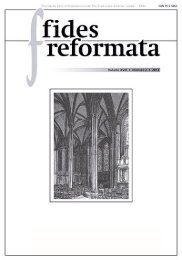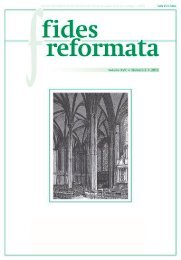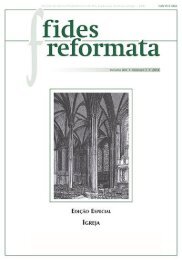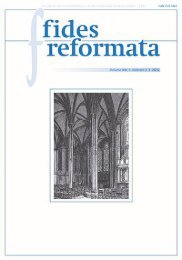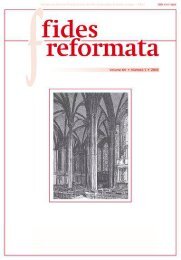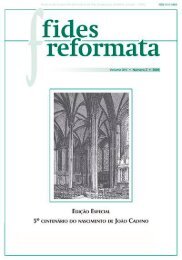You also want an ePaper? Increase the reach of your titles
YUMPU automatically turns print PDFs into web optimized ePapers that Google loves.
FIDES REFORMATA XIX, Nº 2 (2014): 95-115<br />
profession of faith. 33 Think of the purpose for the writing of the whole book<br />
according to verse 20:31 “so that you also may believe” (ἵνα πιστεύ[σ]ητε).<br />
The faith, to which the writer endeavours to arouse the addressees, is closely<br />
connected with and based on past history.<br />
Formally speaking, John <strong>19</strong>:35 is a parenthesis where the text <strong>do</strong>es not<br />
define the subject or the object of seeing. Both need to be derived from the<br />
preceding verses. The witness <strong>do</strong>es not explicitly indicate himself as the author<br />
(that only comes later in 21:24). However he <strong>do</strong>es so implicitly through the<br />
manner in which he addresses the readers with his stated purpose for his testimony.<br />
λέγει is durative: the witness is still speaking; he is more than his book.<br />
Seeing and hearing are closely connected (cf. 1 John 4:14: ἡμεῖς τεθεάμεθα καὶ<br />
μαρτυροῦμεν ὅτι ὁ πατὴρ ἀπέσταλκεν τὸν υἱὸν σωτῆρα τοῦ κόσμου). 34 Why<br />
is his testimony true and trustworthy? 35 Two aspects can be distinguished: 1.<br />
An objective aspect, in connection with the testimony: he saw it himself; 2. A<br />
subjective aspect, from the perspective of the speaker (not the author, though<br />
Scripture too can speak, see the introduction of verse 36): he knows that he<br />
says true things (ἀληθῆ is neuter plural) for Scripture was fulfilled!<br />
Can a person guarantee his own testimony? If he is the only witness then<br />
according to the law of Moses it would not be a valid one (John 5:31-32; in<br />
connection with this see 8:14-18 as well: since Jesus testifies about himself<br />
and that testimony receives confirmation by the Father, it is legal because there<br />
are two witnesses). John <strong>19</strong>:35 however, <strong>do</strong>es not concern the legality of the<br />
witness as such but the content of his testimony as an observed fact. 36 That fact<br />
is ἀληθινὴ, trustworthy, because it has unearthly authenticity, dependability<br />
and quality. The beloved disciple testifies with a good conscience about Jesus’<br />
death on the cross. At the same time, as the conclusion of chapter 21 shows,<br />
he is also the author of the Fourth Gospel. 37<br />
33 BYRSKOG, Samuel. Story as History – History as Story. Tübingen: Mohr Siebeck, 2000,<br />
p. 236-237: “legitimation of the faith of those who were not eyewitnesses”; “the faith of the story is the<br />
faith of history, and vice versa”.<br />
34 See John 1:14; here it concerns his glory on the cross; see John 4:46 for Jesus as the Saviour of<br />
the world.<br />
35 The term ἀληθινὴ points to divine or heavenly truth. See 1:9; 6:32-33; 7:28; 17:3; cf. 1 John<br />
5:20. Would no other witness of the crucifixion have been alive anymore?<br />
36 MORRIS, Leon. The Gospel According to John. NICNT. Grand Rapids: Eerdmans, Revised<br />
Edition, <strong>19</strong>95, p. 725, footnote 100.<br />
37 THYEN is of the opinion that the Roman soldier is presented by the author as witness,<br />
Johannesevangelium, p. 748-749. The Greek word ἐκεῖνος would mark a second subject in the sentence.<br />
Therefore the Church Fathers have often taken this with God or Jesus as subject. However, in 13:25 and<br />
21:7,23 we find ἐκεῖνος in combination with μαθητής referring to the beloved disciple; and it is also used<br />
referring to John the Baptist (5:35 > 5:33 his witness), Moses, the man born blind, Mary of Bethany, and<br />
Peter. ἐκεῖνος is John’s favourite word to refer emphatically to someone, so BERNARD, J.H. A Critical<br />
107






